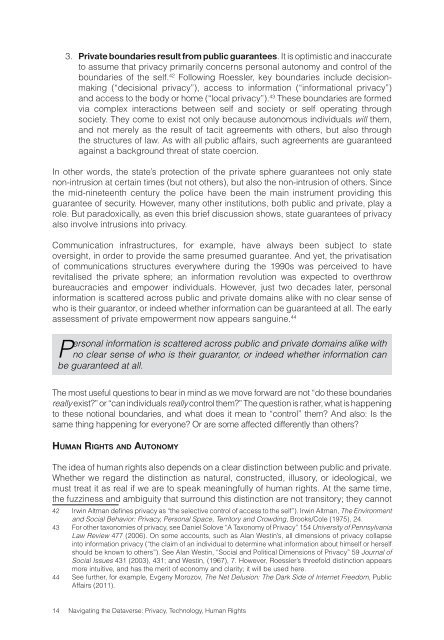Navigating the Dataverse: Privacy, Technology ... - The ICHRP
Navigating the Dataverse: Privacy, Technology ... - The ICHRP
Navigating the Dataverse: Privacy, Technology ... - The ICHRP
Create successful ePaper yourself
Turn your PDF publications into a flip-book with our unique Google optimized e-Paper software.
3. Private boundaries result from public guarantees. It is optimistic and inaccurate<br />
to assume that privacy primarily concerns personal autonomy and control of <strong>the</strong><br />
boundaries of <strong>the</strong> self. 42 Following Roessler, key boundaries include decisionmaking<br />
(“decisional privacy”), access to information (“informational privacy”)<br />
and access to <strong>the</strong> body or home (“local privacy”). 43 <strong>The</strong>se boundaries are formed<br />
via complex interactions between self and society or self operating through<br />
society. <strong>The</strong>y come to exist not only because autonomous individuals will <strong>the</strong>m,<br />
and not merely as <strong>the</strong> result of tacit agreements with o<strong>the</strong>rs, but also through<br />
<strong>the</strong> structures of law. As with all public affairs, such agreements are guaranteed<br />
against a background threat of state coercion.<br />
In o<strong>the</strong>r words, <strong>the</strong> state’s protection of <strong>the</strong> private sphere guarantees not only state<br />
non-intrusion at certain times (but not o<strong>the</strong>rs), but also <strong>the</strong> non-intrusion of o<strong>the</strong>rs. Since<br />
<strong>the</strong> mid-nineteenth century <strong>the</strong> police have been <strong>the</strong> main instrument providing this<br />
guarantee of security. However, many o<strong>the</strong>r institutions, both public and private, play a<br />
role. But paradoxically, as even this brief discussion shows, state guarantees of privacy<br />
also involve intrusions into privacy.<br />
Communication infrastructures, for example, have always been subject to state<br />
oversight, in order to provide <strong>the</strong> same presumed guarantee. And yet, <strong>the</strong> privatisation<br />
of communications structures everywhere during <strong>the</strong> 1990s was perceived to have<br />
revitalised <strong>the</strong> private sphere; an information revolution was expected to overthrow<br />
bureaucracies and empower individuals. However, just two decades later, personal<br />
information is scattered across public and private domains alike with no clear sense of<br />
who is <strong>the</strong>ir guarantor, or indeed whe<strong>the</strong>r information can be guaranteed at all. <strong>The</strong> early<br />
assessment of private empowerment now appears sanguine. 44<br />
Personal information is scattered across public and private domains alike with<br />
no clear sense of who is <strong>the</strong>ir guarantor, or indeed whe<strong>the</strong>r information can<br />
be guaranteed at all.<br />
<strong>The</strong> most useful questions to bear in mind as we move forward are not “do <strong>the</strong>se boundaries<br />
really exist?” or “can individuals really control <strong>the</strong>m?” <strong>The</strong> question is ra<strong>the</strong>r, what is happening<br />
to <strong>the</strong>se notional boundaries, and what does it mean to “control” <strong>the</strong>m? And also: Is <strong>the</strong><br />
same thing happening for everyone? Or are some affected differently than o<strong>the</strong>rs?<br />
Human Rights and Autonomy<br />
<strong>The</strong> idea of human rights also depends on a clear distinction between public and private.<br />
Whe<strong>the</strong>r we regard <strong>the</strong> distinction as natural, constructed, illusory, or ideological, we<br />
must treat it as real if we are to speak meaningfully of human rights. At <strong>the</strong> same time,<br />
<strong>the</strong> fuzziness and ambiguity that surround this distinction are not transitory; <strong>the</strong>y cannot<br />
42 Irwin Altman defines privacy as “<strong>the</strong> selective control of access to <strong>the</strong> self”). Irwin Altman, <strong>The</strong> Environment<br />
and Social Behavior: <strong>Privacy</strong>, Personal Space, Territory and Crowding, Brooks/Cole (1975), 24.<br />
43 For o<strong>the</strong>r taxonomies of privacy, see Daniel Solove “A Taxonomy of <strong>Privacy</strong>” 154 University of Pennsylvania<br />
Law Review 477 (2006). On some accounts, such as Alan Westin’s, all dimensions of privacy collapse<br />
into information privacy (“<strong>the</strong> claim of an individual to determine what information about himself or herself<br />
should be known to o<strong>the</strong>rs”). See Alan Westin, “Social and Political Dimensions of <strong>Privacy</strong>” 59 Journal of<br />
Social Issues 431 (2003), 431; and Westin, (1967), 7. However, Roessler’s threefold distinction appears<br />
more intuitive, and has <strong>the</strong> merit of economy and clarity; it will be used here.<br />
44 See fur<strong>the</strong>r, for example, Evgeny Morozov, <strong>The</strong> Net Delusion: <strong>The</strong> Dark Side of Internet Freedom, Public<br />
Affairs (2011).<br />
14 <strong>Navigating</strong> <strong>the</strong> <strong>Dataverse</strong>: <strong>Privacy</strong>, <strong>Technology</strong>, Human Rights
















